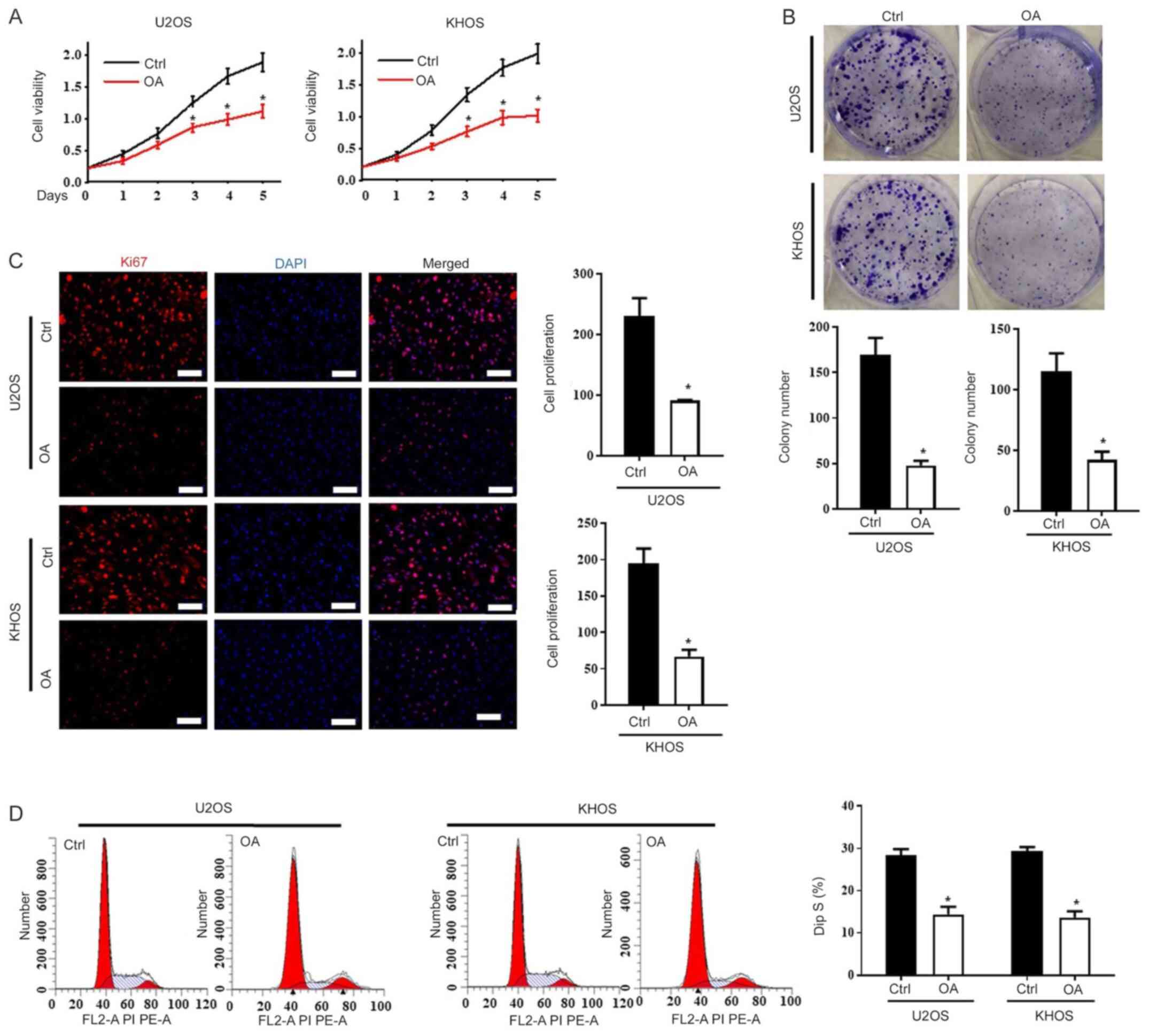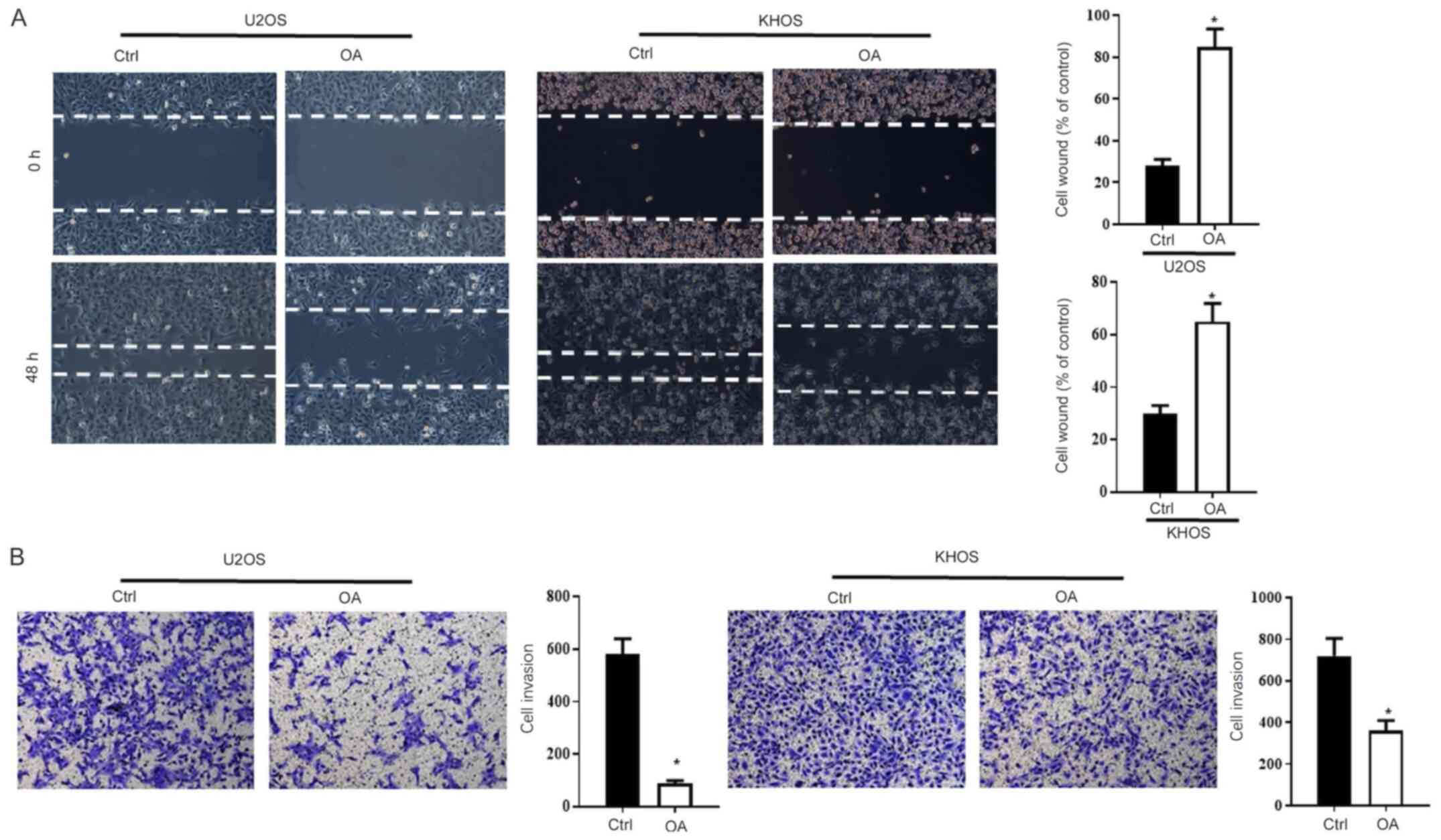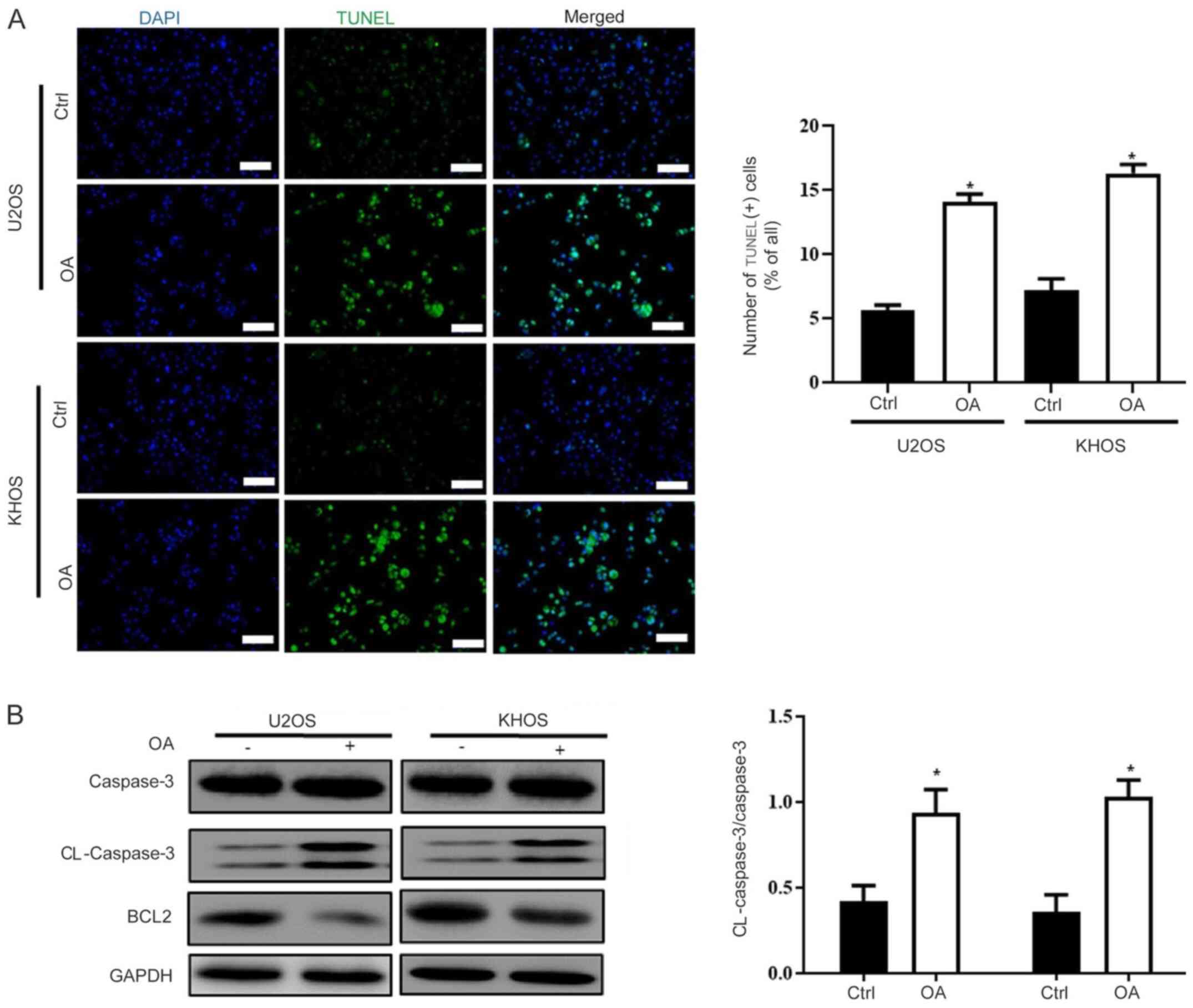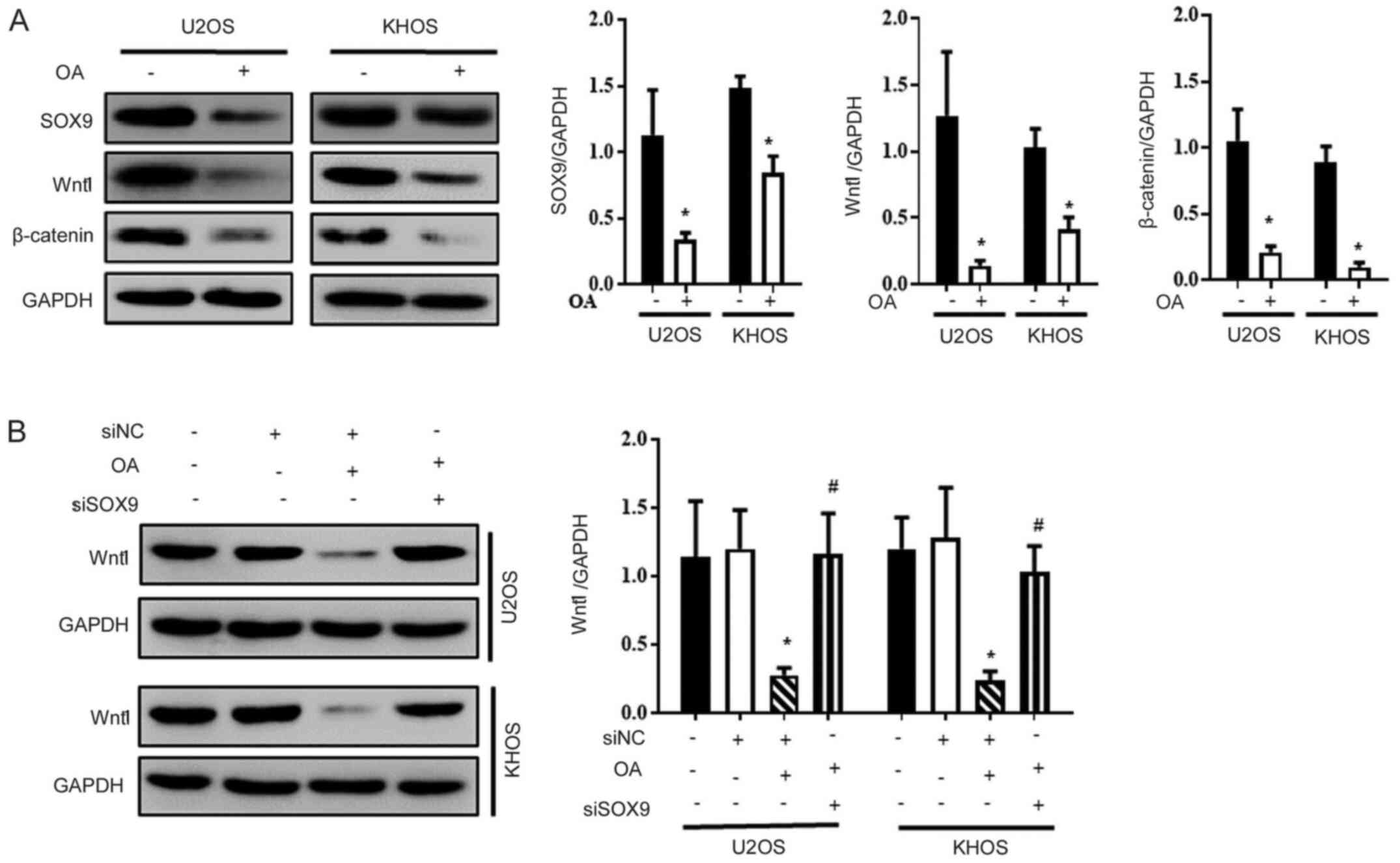|
1
|
Sadykova LR, Ntekim AI, Muyangwa-Semenova
M, Rutland CS, Jeyapalan JN, Blatt N and Rizvanov AA: Epidemiology
and risk factors of osteosarcoma. Cancer Invest. 38:259–269.
2020.PubMed/NCBI View Article : Google Scholar
|
|
2
|
Morrow JJ, Bayles I, Funnell APW, Miller
TE, Saiakhova A, Lizardo MM, Bartels CF, Kapteijn MY, Hung S,
Mendoza A, et al: Positively selected enhancer elements endow
osteosarcoma cells with metastatic competence. Nat Med. 24:176–185.
2018.PubMed/NCBI View
Article : Google Scholar
|
|
3
|
Liu H, Chen Y, Zhou F, Jie L, Pu L, Ju J,
Li F, Dai Z, Wang X and Zhou S: Sox9 regulates hyperexpression of
Wnt1 and Fzd1 in human osteosarcoma tissues and cells. Int J Clin
Exp Pathol. 7:4795–4805. 2014.PubMed/NCBI
|
|
4
|
Wang S, Zhang D, Han S, Gao P, Liu C, Li J
and Pan X: Fibulin-3 promotes osteosarcoma invasion and metastasis
by inducing epithelial to mesenchymal transition and activating the
Wnt/β-catenin signaling pathway. Sci Rep. 7(6215)2017.PubMed/NCBI View Article : Google Scholar
|
|
5
|
Zou J, Zhang W and Li XL: Effects of SOST
gene silencing on proliferation, apoptosis, invasion, and migration
of human osteosarcoma cells through the wnt/β-catenin signaling
pathway. Calcif Tissue Int. 100:551–564. 2017.PubMed/NCBI View Article : Google Scholar
|
|
6
|
Xu Y, Shu B, Tian Y, Wang G, Wang Y, Wang
J and Dong Y: Oleanolic acid induces osteosarcoma cell apoptosis by
inhibition of Notch signaling. Mol Carcinog. 57:896–902.
2018.PubMed/NCBI View
Article : Google Scholar
|
|
7
|
Gao F, Zuo Q, Jiang T, Song H and Zhou J:
A newly synthesized oleanolic acid derivative inhibits the growth
of osteosarcoma cells in vitro and in vivo by decreasing
c-MYC-dependent glycolysis. J Cell Biochem. 120:9264–9276.
2019.PubMed/NCBI View Article : Google Scholar
|
|
8
|
Shanmugam MK, Dai X, Kumar AP, Tan BK,
Sethi G and Bishayee A: Oleanolic acid and its synthetic
derivatives for the prevention and therapy of cancer: Preclinical
and clinical evidence. Cancer Lett. 346:206–216. 2014.PubMed/NCBI View Article : Google Scholar
|
|
9
|
Fan X, Wang P, Sun Y, Jiang J, Du H, Wang
Z, Duan Z, Lei H and Li H: Oleanolic acid derivatives inhibit the
Wnt/β-catenin signaling pathway by promoting the phosphorylation of
beta-catenin in human SMMC-7721 cells. Pharmazie. 71:398–401.
2016.PubMed/NCBI View Article : Google Scholar
|
|
10
|
Wang YY, Yang YX, Zhao R, Pan ST, Zhe H,
He ZX, Duan W, Zhang X, Yang T, Qiu JX and Zhou SF: Bardoxolone
methyl induces apoptosis and autophagy and inhibits
epithelial-to-mesenchymal transition and stemness in esophageal
squamous cancer cells. Drug Des Devel Ther. 9:993–1026.
2015.PubMed/NCBI View Article : Google Scholar
|
|
11
|
Landers JE, Cassel SL and George DL:
Translational enhancement of mdm2 oncogene expression in human
tumor cells containing a stabilized wild-type p53 protein. Cancer
Res. 57:3562–3568. 1997.PubMed/NCBI
|
|
12
|
Rhim JS, Cho HY, Vernon ML, Arnstein P,
Huebner RJ and Gilden RV: Characterization of non-producer human
cells induced by Kirsten sarcoma virus. Int J Cancer. 16:840–849.
1975.PubMed/NCBI View Article : Google Scholar
|
|
13
|
Duan L, Yang Z, Jiang X, Zhang J and Guo
X: Oleanolic acid inhibits cell proliferation migration and
invasion and induces SW579 thyroid cancer cell line apoptosis by
targeting forkhead transcription factor A. Anticancer Drugs.
30:812–820. 2019.PubMed/NCBI View Article : Google Scholar
|
|
14
|
Hotchkiss RS, Strasser A, McDunn JE and
Swanson PE: Cell death. N Engl J Med. 361:1570–1583.
2009.PubMed/NCBI View Article : Google Scholar
|
|
15
|
Zhang SL, Yang ZN, He C, Liao HB, Wang HS,
Chen ZF and Liang D: Oleanane-type triterpenoid saponins from
lysimachia fortunei maxim. Phytochemistry. 147:140–146.
2018.PubMed/NCBI View Article : Google Scholar
|
|
16
|
Peng XP, Li XH, Li Y, Huang XT and Luo ZQ:
The protective effect of oleanolic acid on NMDA-induced MLE-12
cells apoptosis and lung injury in mice by activating SIRT1 and
reducing NF-kB acetylation. Int Immunopharmacol. 70:520–529.
2019.PubMed/NCBI View Article : Google Scholar
|
|
17
|
Žiberna L, Šamec D, Mocan A, Nabavi SF,
Bishayee A, Farooqi AA, Sureda A and Nabavi SM: Oleanolic acid
alters multiple cell signaling pathways: Implication in cancer
prevention and therapy. Int J Mol Sci. 18(643)2017.PubMed/NCBI View Article : Google Scholar
|
|
18
|
Zhu YY, Huang HY and Wu YL: Anticancer and
apoptotic activities of oleanolic acid are mediated through cell
cycle arrest and disruption of mitochondrial membrane potential in
HepG2 human hepatocellular carcinoma cells. Mol Med Rep.
12:5012–5018. 2015.PubMed/NCBI View Article : Google Scholar
|
|
19
|
Liese J, Hinrichs TM, Lange M and Fulda S:
Cotreatment with sorafenib and oleanolic acid induces reactive
oxygen species-dependent and mitochondrial-mediated apoptotic cell
death in hepatocellular carcinoma cells. Anticancer Drugs.
30:209–217. 2019.PubMed/NCBI View Article : Google Scholar
|
|
20
|
Kim GJ, Jo HJ, Lee KJ, Choi JW and An JH:
Oleanolic acid induces p53-dependent apoptosis via the ERK/JNK/AKT
pathway in cancer cell lines in prostatic cancer xenografts in
mice. Oncotarget. 9:26370–26386. 2018.PubMed/NCBI View Article : Google Scholar
|
|
21
|
Zhu B, Ren C, Du K, Zhu H, Ai Y, Kang F,
Luo Y, Liu W, Wang L, Xu Y, et al: Olean-28,13b-olide 2 plays a
role in cisplatin-mediated apoptosis and reverses cisplatin
resistance in human lung cancer through multiple signaling
pathways. Biochem Pharmacol. 170(113642)2019.PubMed/NCBI View Article : Google Scholar
|
|
22
|
Khan MW, Zhao P, Khan A, Raza F, Raza SM,
Sarfraz M, Chen Y, Li M, Yang T, Ma X and Xiang G: Synergism of
cisplatin-oleanolic acid co-loaded calcium carbonate nanoparticles
on hepatocellular carcinoma cells for enhanced apoptosis and
reduced hepatotoxicity. Int J Nanomedicine. 14:3753–3771.
2019.PubMed/NCBI View Article : Google Scholar
|
|
23
|
Shi Y, Song Q, Hu D, Zhuang X, Yu S and
Teng D: Oleanolic acid induced autophagic cell death in
hepatocellular carcinoma cells via PI3K/Akt/mTOR and ROS-dependent
pathway. Korean J Physiol Pharmacol. 20:237–243. 2016.PubMed/NCBI View Article : Google Scholar
|
|
24
|
Nie H, Wang Y, Qin Y and Gong XG:
Oleanolic acid induces autophagic death in human gastric cancer
cells in vitro and in vivo. Cell Biol Int. 40:770–778.
2016.PubMed/NCBI View Article : Google Scholar
|
|
25
|
Khurana N and Sikka SC: Interplay between
SOX9, Wnt/β-catenin and androgen receptor signaling in
castration-resistant prostate cancer. Int J Mol Sci.
20(2066)2019.PubMed/NCBI View Article : Google Scholar
|
|
26
|
Yu Y, Yin W, Yu ZH, Zhou YJ, Chi JR, Ge J
and Cao XC: miR-190 enhances endocrine therapy sensitivity by
regulating SOX9 expression in breast cancer. J Exp Clin Cancer Res.
38(22)2019.PubMed/NCBI View Article : Google Scholar
|
|
27
|
Domenici G, Aurrekoetxea-Rodriguez I,
Simoes BM, Rábano M, Lee SY, Millán JS, Comaills V, Oliemuller E,
López-Ruiz JA, Zabalza I, et al: A Sox2-Sox9 signalling axis
maintains human breast luminal progenitor and breast cancer stem
cells. Oncogene. 38:3151–3169. 2019.PubMed/NCBI View Article : Google Scholar
|
|
28
|
Suh N, Paul S, Lee HJ, Yoon T, Shah N, Son
AI, Reddi AH, Medici D and Sporn MB: Synthetic triterpenoids,
CDDO-Imidazolide and CDDO-Ethyl amide, induce chondrogenesis.
Osteoarthritis Cartilage. 20:446–450. 2012.PubMed/NCBI View Article : Google Scholar
|
|
29
|
Borella R, Forti L, Gibellini L, De
Gaetano A, De Biasi S, Nasi M, Cossarizza A and Pinti M: Synthesis
and anticancer activity of CDDO and CDDO-Me, two derivatives of
natural triterpenoids. Molecules. 24(4097)2019.PubMed/NCBI View Article : Google Scholar
|
|
30
|
Lin C, Wen X and Sun H: Oleanolic acid
derivatives for pharmaceutical use: A patent review. Expert Opin
Ther Pat. 26:643–655. 2016.PubMed/NCBI View Article : Google Scholar
|
|
31
|
Oh HJ, Kido T and Lau YF: PIAS1 interacts
with and represses SOX9 transactivation activity. Mol Reprod Dev.
74:1446–1455. 2007.PubMed/NCBI View Article : Google Scholar
|
|
32
|
Hattori T, Eberspaecher H, Lu J, Zhang R,
Nishida T, Kahyo T, Yasuda H and de Crombrugghe B: Interactions
between PIAS proteins and SOX9 result in an increase in the
cellular concentrations of SOX9. J Biol Chem. 281:14417–14428.
2006.PubMed/NCBI View Article : Google Scholar
|
|
33
|
Saotome H, Ito A, Kubo A and Inui M:
Generation of a quantitative luciferase reporter for Sox9
SUMOylation. Int J Mol Sci. 21(1274)2020.PubMed/NCBI View Article : Google Scholar
|
|
34
|
Wu J, Lei H, Zhang J, Chen X, Tang C, Wang
W, Xu H, Xiao W, Gu W and Wu Y: Momordin Ic, a new natural SENP1
inhibitor, inhibits prostate cancer cell proliferation. Oncotarget.
7:58995–59005. 2016.PubMed/NCBI View Article : Google Scholar
|


















